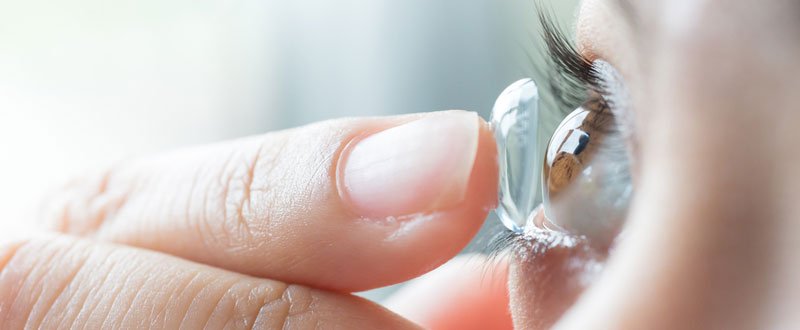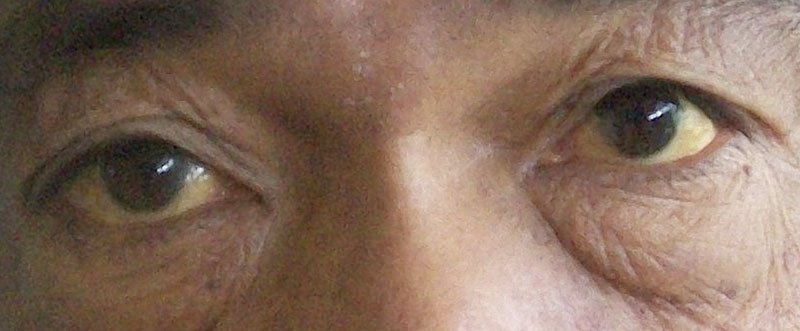Contact lenses are the perfect solution for those who do not want to wear spectacles and do not want a surgical vision correction also. Contact lenses do not restrict your field of vision (no edge effects due to the spectacle frame) and move with the eye, and significantly reduce distortions. Also unlike glasses, they do not fog up or result in reduced visibility in the rain. Contact lenses offer better cosmesis and are more practical for sports and outdoor activities than glasses.
However, contact lenses do come with some problems, and this article will be discussing them in detail, to help you choose the best option for your eye health and visual needs.
1. Limited Wearing Time: Unlike glasses which can be worn during all waking hours, the wearing time of contact lenses is less and dependent on the type of lenses. Most doctors advocate wearing contact lenses for a maximum of eight hours, and caution their patients against sleeping with the contact lens in the eye. Extended wear lenses can be worn for longer durations, up to a week but require regular monitoring and care to avoid complications like infections.
2. Discomfort, especially after a day-long use of lenses: When you start wearing lenses, some amount of discomfort is usual, as the eye gradually adapts to the foreign object. That is why most ophthalmologists and eye care professionals ask you to start with wearing the lenses for a few hours, and gradually increasing the duration of lens usage to a full day. In case the discomfort persists, you must get your eyes checked by the prescribing doctor to see if the lens is a good fit for your eyes or if you will benefit from shifting to another class of lenses, with a higher oxygen permeability. Typically, silicone hydrogel lenses and soft lenses are more comfortable, but rigid gas permeable or RGP lenses come with the added advantages of offering correction of significant astigmatism and presbyopia also. This is because RGP bifocals are also available.
3. Dry Eye: Almost all contact lens users have a degree of dry eye, even if they have no symptoms. The symptoms of dry eye include:
- Dryness of eyes with attendant discomfort
- Foreign body sensation or gritty eyes
- Redness of eyes, along with soreness
- Excessive watering
- Sensitivity to light and glare
The lenses that have a decreased incidence of dry eye include silicone hydrogel lenses, low water content lenses, and daily disposable lenses. The latter is recommended because in these there are no protein deposit build-ups which result in more comfort.
Usually, most dry eye patients respond well to a change in the quality of lenses or the addition of preservative free lubricating eye drops. These eye drops help moisturize your eyes, making blinking easier and smoother, thereby increasing the comfort.
4. Eye Allergies: Some contact lens wearers may suffer from eye allergies since the lenses could be a source of chronic irritation, especially if they are not cleaned properly. Accumulation of debris and the associated dry eye may compound the wearer’s discomfort. Some people may suffer from allergies to the contact lens cleaning solution. To avoid and manage allergies, make sure you clean your lenses regularly. You may even want to discuss with your doctor if you can switch to daily disposable lenses, or change your contact lens cleaning solution. If required, your eye doctor may prescribe anti-allergy eye drops, and recommend a brief period of no contact lens. It may help your eyes feel better.
Discuss with your optician whether you need to switch lens care products or even change to daily disposable lenses. They may even be able to prescribe eye drops to alleviate the symptoms, which can include eye twitching.
5. Handling Contact Lenses: Wearing and taking off contact lenses may be cumbersome for some people, especially in the initial days, and if your eye power is high. Some people also find it difficult to identify if the contact lens is inside out. Below are some critical rules of the thumb to follow, so that you can handle your contact lenses better.
- Meticulous hand hygiene: Make sure you wash your hands properly with soap and water to avoid eye infections, before both wearing, and taking of contact lenses.
- Make sure your nails are clipped to avoid injury to your cornea and to prevent tearing your contact lenses.
- Make sure you have put on and taken off your lenses independently, at least twice before you walk out of your eye care provider’s chambers. If you are not confident of handling your lenses, ask your doctor to repeat the steps with you one more time.
- To make sure that your lens is not inside out, place it on your finger. You will see that it looks like a cup. Hold it up directly in front of your eyes. If it looks like a bowl, or a curved “U”, its okay. If the edges appear to flare out, like a bowl with a rim, it’s inside out. Usually, if you wear the lens with the wrong side in, it does not cause any damage, except feeling You can then take it out, and reinsert it, right side.
6. Infections: The most significant concern with contact lenses is the increased risk for eye infections. These can range from innocuous eye infections to more severe vision-threatening eye ulcers. It is, therefore, better to be very careful about hygiene in handling contact lenses. The following are some dos and don’ts to ensure eye health in contact lens users. Daily disposable lenses carry a lesser risk of infections.
- Meticulous hand hygiene as discussed earlier.
- Make sure to disinfect and contact lenses and lens storage cases as per your eye doctor’s instructions.
- Make sure your lenses are discarded and replaced in accordance with your doctor’s advice.
- Do not over wear lenses, that is, do not wear them for longer durations than allowed by your doctor. Discuss extended wear of lenses if you think you need to wear them for longer durations.
- Don’tuse tap water instead of lens cleaning solution to clean or store your lenses.
- Don’t top off old solution in your contact lens case. You must discard the old solution, clean the lens case and replace it with fresh solution every time. Also, make sure your contact lens cleaning solution is not past its expiration date.
- Don’t use your saliva or tap water to wet the lenses. In case you experience dryness, your eye doctor will be happy to suggest preservative free lubricating eye drops which are safe to use with your lenses in the eye.
- In case of redness, pain, discomfort, sensitivity to light more than usual or any purulent discharge from the eyes, or decrease in vision, you must contact your eye doctor immediately. These could be signs of an eye infection or even an injury to the cornea.
7. Eye Makeup: Any makeup inside your eye can cause significant eye irritation, and make cause eye injuries too. For people who wear contact lenses, this is an added problem, because makeup particles can stick to the contact lenses, and be more cumbersome to flush out. Below are some handy hints to help you wear your eye makeup without troubling your eyes, especially if you wear contact lenses.
- Make sure you wear your contact lenses before applying makeup. In case you have used a facial cleanser, cream or toner, make sure you clean your hands thoroughly with soap and water to avoid any risk of contamination.
- Choose your eye makeup well. It is wiser to invest in a trusted brand which is known to be hypoallergenic than to end up with swollen eyes.
- Also, check the best before or expiry date on your eye makeup. Make sure you make a note of the day you opened the seal on the product. Most mascaras and eyeliners should be discarded three to six months from the date of opening, even if not past the date of expiration, to avoid the risk of eye infections.
- Cream eyeshadow is safer to use when wearing contact lenses. A water-based product is less damaging if it enters the eye than an oily base. If you decide to wear a powder eyeshadow, make sure you close your eye when putting it on.
- Never apply eyeliner or kajal/ kohl on the waterline, that us between your lashes and your eye. Even homemade kajal or that made by your grandmother using ghee is not safe enough for use inside the eye.
- To remove eye makeup, wash and dry your hands. Then remove your contacts, being careful not to bump them into any makeup. Finally, use your eye makeup remover.
- Make sure you don’t share your eye makeup with others to avoid infections and cross contamination.
8. Cleaning Contact Lenses: Cleaning and maintenance of contact lenses is not very difficult. Hygiene and cleaning instructions must be followed meticulously. It may seem cumbersome at the outset, but does not take too much time, and you will get used to the process very soon. The following are the rules that must be followed:
- Make sure you use the sterile contact lens solution, and check its expiry date. Try and use the specific solution recommended for your lenses, even though using an alternate brand does not usually compromise your lenses in any way. Using tap water can lead to infections, and deposits on the contact lens, both of which can have disastrous results.
- You must also clean the contact lens case each day, and throw out the old solution before refilling it with a new solution from the bottle.
- Do not use saliva, distilled water or eye drops to clean your lenses.
- If you want to avoid the hassle of contact lens cleaning and care altogether, talk to your doctor about daily disposable contact lenses. These are more expensive than the other contact lenses, but come with the added advantage of ease of use and better comfort, as well as reduced chances of infections.
9. Protection from Ultraviolet Radiation: Damage to the eye by UV rays of the sun has been proven without a doubt, with UV rays increasing the incidence of cataracts, age-related macular degeneration and pterygium. In fact, The American Optometric Association (AOA) recommends that you must wear sunglasses that block 99-100 percent of UV-A and UV-B rays. However, all styles of sunglasses do not entirely protect the eye. Therefore, the recommended sunglasses are usually of the wraparound style or over-sized “film star” like shades.
Certain contact lenses offer additional UV protection, however, do not protect the entire eye or the surrounding delicate under eye skin which is very prone to the effects of ageing.
The U.S. Food and Drug Administration FDA has set specific standards for UV-blocking contact lenses. These are as following:
- FDA Class I blocker. These block more than
- 90% of UVA (316-380 nm wavelengths) and
- 99% of UVB (280 – 315 nm).
- Recommended for use in mountain peaks, areas with snow with increased exposure to sunlight and glare, and for outdoor sports.
- FDA Class II blocker. These block around
- 70% of UVA and
- 95% of UVB
- Recommended for use in day to day activities.
10. Serious Eye Disorders: Even though the most common problems associated with contact lens use are innocuous and only cause discomfort and watering, there are certain diseases which can be potentially more severe. These are usually characterized by pain, blurring of vision, increased sensitivity to light and excessive watering or mucus discharge from the eyes. Any of these symptoms mean you must discontinue wearing lenses immediately, and seek medical attention. The diseases which could potentially be associated with contact lens use include blepharitis, conjunctivitis, corneal ulcer, keratitis, corneal abrasion, etc.
Contact lenses can significantly improve your quality of life by decreasing your dependence on spectacles, without surgical intervention. However, their use requires meticulous care and attention to hygiene.






